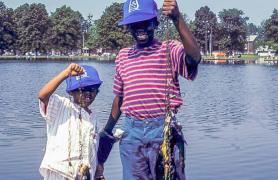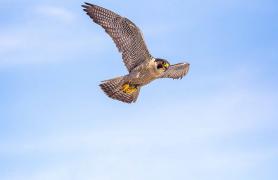It’s April. You’re out scouting your favorite conservation area for turkey sign and morels. You spot some other folks carrying cloth bags and poking around a sunny, south-facing slope. They might be looking for morels, too.
Or they might be poachers.
“If they’re carrying a cloth bag, and they’re in these sunny, south-facing rocky slopes, they may be collecting snakes,” said Jason Braunecker, MDC protection district supervisor.
Yes, he said, “collecting snakes.”
Missouri State Herpetologist Jeff Briggler explained further. “It’s the same with people who like to collect rare plants or rare birds — they’re looking for exotic colors and unusual markings.
“It takes wild genes to produce new variations,” Briggler said. “Some people will keep snakes for themselves, but there’s a big market for wild snakes, amphibians, and reptiles worldwide.”
That’s the problem, Braunecker said. “Unlawful commercialization.”
The Illegal Pet Trade Hurts Everyone
In their March 3, 2016, National Geographic blog post, writers Susan Lieberman and Elizabeth Bennett summarized the “current crisis of the global illegal trade in wildlife for use as pets.”
“From Peruvian titi monkeys to Central Africa’s African gray parrots to Madagascar’s plowshare tortoises, the illegal global pet trade threatens countless species, sending many hurtling toward extinction,” they wrote.
The effects of this global illegal trade are felt here in Missouri, where 33 of the state’s 118 species of native amphibians and reptiles (collectively known as herptiles or herps) are listed as species of conservation concern. Several are state or federally endangered. Braunecker sees the impact of the illegal pet trade on Missouri’s herps in his daily work. He reports that MDC’sProtection Division makes several cases annually from people selling native snakes or turtles taken from the wild.
“Craigslist and Facebook Marketplace sites as well as other herp forums are hot places for people to sell,” he said. When people collect local wildlife to serve the demand for unusual or rare animals, they may earn a few quick bucks, but they’re essentially killing the goose that laid the golden egg. “Unlawful commercialization of wildlife doesn’t just hurt the species,” Braunecker said. “It hurts the whole ecosystem, and it robs us of our natural heritage.”
All wildlife plays a role in nature. Most reptiles and amphibians are predators. Their job is to keep populations of prey animals like worms, bugs, and mice in balance. They also serve as food for other, larger predators like fish, birds, and mammals. If we start thinking of herptiles — or any wildlife — as pets, collectibles, trophies, or commodities used for monetary gain, we’re guilty of commercializing them. This creates an unsustainable demand for wildlife that may already be at risk and can’t be replaced.
“Poaching these animals for the pet trade just pushes them a little closer toward the edge of existence,” Briggler said. “Even searching for them, like digging or turning over rocks, can destroy their habitat.”
Reducing or wiping out local herptile species can also further impoverish already-struggling local economies. Trying to replace free ecosystem services like pest-control can prove astronomically expensive.
In addition, eliminating wildlife species could rob humanity of sources of important medical treatments. For example, scientists are studying how the Indonesian Komodo dragon’s ability to avoid infection and recover from injuries could help people heal faster, with fewer risks of infection. Research continues into the use of snake venom in anti-cancer drugs. According to a report on the National Center for Biotechnology Information website, “There is a continuous development of new drugs from snake venom for … anti-cancer agents.”
Just One of Many Global Pressures
As a group, herptiles are declining worldwide. Poaching is just one of many pressures that are threatening them. Loss
of habitat, construction, disease, invasive species, and fire are also driving declines.
Ironically, it’s also the international pet trade that introduces nonnative species, and their diseases, from other continents into our local ecosystems (and vice versa).
In Florida, the Burmese python and the Nile monitor lizard are eating their way through that state’s endangered species, according to Chris Sweeney in Audubon magazine. So far, Missouri is too far north to permit the survival of tropical herptiles, but Briggler and other scientists worry that it’s just a matter of time before Missouri sees the appearance of pathogens like the fungus Batrachochytrium salamandrivorans, which spread from Asia via the pet trade and is attacking salamanders in Europe.
How We Protect and Conserve Them
Missouri has a robust code of regulations that empowers MDC’s conservation agents to address poachers, including those involved in the illegal pet trade, through enforcement action. Agents rely heavily on tips from ethical hobbyists, said Braunecker.
“Having eyes in local communities helps a lot,” he said.
In addition to a statewide network of trained protection staff and local law enforcement agents, Missouri has a large collection of nearly 1,000 conservation and natural areas that provide the habitat our state’s herps need to feed, breed, and thrive.
“High-quality natural communities ranging from desertlike glades to dense swamps conserved on designated Missouri natural areas provide important sites for many of our state’s herptiles,” said Mike Leahy, MDC natural community ecologist.
MDC’s Outreach and Education Division, including publications, exhibits, and nature and interpretive centers, also helps educate citizens and stakeholders about the role and value of snakes and other herps in Missouri’s natural communities.
“Spotting a prairie lizard sunning on a rock or hearing a chorus of spring peepers in the evening can make our day,” said Kevin Lohraff, Runge Nature Center manager. “It is deeplysatisfying work to help people understand that having healthy populations of amphibians and reptiles enriches our lives.”
How You Can Help
Know Missouri’s snakes
Being able to identify Missouri’s native snakes and other herps not only enriches your knowledge and enjoyment of our state’s natural history, it can also help you to spot illegal wildlife activity when you see it.
To help you learn more, care more, and do more for the Show-Me State’s snakes, MDC offers several free, online, and for-sale publications. A Guide to Missouri’s Snakes is free to Missouri residents. You can pick up a copy at most MDC nature and interpretive centers, or email pubstaff@mdc. mo.gov to order a copy. Browse more than 40 snake entries in MDC’s online Field Guide at mdc.mo.gov/field-guide. The Amphibians and Reptiles of Missouri, a 368-page book by former Missouri State Herpetologist Tom R. Johnson, is available at most MDC nature and interpretive centers, or you can buy it online at mdcnatureshop.com.
If you see something, say something You don’t have to be outdoors to spot a possible snake-poaching situation. If you’re browsing a social media site and see a Missouri native snake for sale, you may be viewing a poached animal. Take a quick screen grab of the image and email it to Jeff.Briggler@mdc.mo.gov. You can also report suspicious activity via Operation Game Thief (OGT). Just call 1-800-392-1111.
“Many of these (poaching) cases were made by people passing the information onto us through an OGT call,” said Braunecker.
Ask tough questions
Braunecker advises asking sellers where their snakes come from. “I would suggest if you’re going to purchase a snake, ensure you’re not purchasing a snake taken from the wild. If it’s a Missouri snake taken from the wild, the person should not be selling it,” he said.
Don’t collect! Capture, observe, and release
Missouri State Herpetologist Jeff Briggler helps agents identify the reptiles and amphibians they find in poaching cases. In fact, this duty makes up 15 to 20 percent of his workload. Although he’s the state’s most ardent advocate for all things scaly and slimy, he confessed he likes the idea of parents legally picking up common, harmless reptiles like the gartersnake. (See Know the Code.)
“Just handle them carefully,” he said. “Support snakes, in particular, near the head and tail, and don’t keep them too long.” Briggler, who has three children of his own, said it’s important that kids learn that most wild snakes, turtles, and frogs can’t hurt you.
“But these wildlife are sensitive, and it can be difficult to keep them in good condition in captivity,” he said. “It’s best to put them back where you found them as soon as you can.”
Don’t post pics to social media sites
Both Briggler and Braunecker urge people not to post photos of the herps they find on social media. “Doing so may help poachers determine specific locations to target species, further harming already sensitive populations,” said Braunecker.
Make room for snakes on your land
In addition to poaching, disease, and persecution, loss of habitat is one of the top factors driving declines in the world’s herp populations. If you own your own home or rural property,you can make a place for herps. Just create an out-of-the-way brush pile or stone wall where snakes, lizards, turtles, and toads can thrive. A small fishless pond will attract frogs, salamanders, and aquatic turtles. Soon you’ll have fewer mice and insect pests, and your local area will have more native herptiles.
Support local prosecutors
Braunecker said that conservation agents working with local prosecutors are key in bringing poachers to justice, and he encourages people to support stiff penalties. “If people are illegally taking or killing snakes or other herps, please let your local conservation agent know so they can investigate and pursue charges through local prosecution,” he said.
Know the Code
According to Braunecker, the Wildlife Code of Missouri is a permissive code. “It allows citizens to keep up to five native species of herps except endangered species, species that are extremely rare, any venomous snake, and those species with established seasons, such as bullfrogs and snapping turtles,” he said.
Also, he said, many conservation areas don’t allow plant or animal collecting or digging of any sort, so check with the area manager before collecting species or disturbing habitat in any way. He said that visitors may collect mushrooms on conservation areas, but “they just can’t sell them.”
When does taking wildlife become poaching wildlife?
“When you take a protected species such as a dusty hog-nosed snake or keep more than five individuals of native herps allowed to be possessed by the Wildlife Code,” Braunecker said.
Most importantly, if you barter, trade, sell, or transport outside state lines any live native Missouri species taken from the wild, you’ve broken the law.


















Also In This Issue


And More...
This Issue's Staff
Associate Editor - Larry Archer
Staff Writer - Bonnie Chasteen
Staff Writer - Heather Feeler
Staff Writer - Kristie Hilgedick
Staff Writer - Joe Jerek
Creative Director - Stephanie Thurber
Art Director - Cliff White
Designer - Les Fortenberry
Designer - Marci Porter
Photographer - Noppadol Paothong
Photographer - David Stonner
Circulation - Laura Scheuler






















